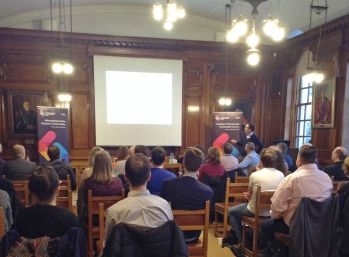 The latest Administrative Data Research Centre Wales (ADRC-W) seminar on ‘Alcohol Consumption and Population Health’ took place today at Cardiff University’s main building. ADRC-W provides a data linkage service and is one of four UK centres within the Administrative Data Research Network (ADRN). The centre is located within Swansea University and the Wales Institute of Social and Economic Research, Data and Methods (WISERD) at Cardiff and research can be used to inform policy makers in deciding how to tackle a range of complex social, economic, environmental and health issues.
The latest Administrative Data Research Centre Wales (ADRC-W) seminar on ‘Alcohol Consumption and Population Health’ took place today at Cardiff University’s main building. ADRC-W provides a data linkage service and is one of four UK centres within the Administrative Data Research Network (ADRN). The centre is located within Swansea University and the Wales Institute of Social and Economic Research, Data and Methods (WISERD) at Cardiff and research can be used to inform policy makers in deciding how to tackle a range of complex social, economic, environmental and health issues.
The event was attended by policy makers, social scientists, statisticians and others interested in social and health research. Delegates came to find out more about how administrative data from Wales and Scotland has been utilised to carry out research on alcohol consumption and alcohol-related harm.
One focus of the event was around the change in alcohol outlet density and alcohol-related harm to population health (CHALICE), a comprehensive record-linked database study in Wales. The CHALICE study carried out a natural experiment of change in alcohol outlet density between 2006 and 2011 in Wales on alcohol consumption and alcohol related harm, using novel geographic information system (GIS), administrative and survey data linkage and statistical methods.
Speakers explored different topics around the CHALICE study and included Dr Scott Orford, from the Wales Institute of Social and Economic Research, Data and Methods (WISERD) and Cardiff University, Dr Richard Fry, from the Farr Institute and Swansea University’s Medical School, and Professor David Fone, also from the Farr Institute, and based in Cardiff University’s School of Medicine.
Professor Jamie Pearce, from the Centre for Research on Environment Society and Health (CRESH) and the University of Edinburgh presented findings from Scotland on alcohol outlet density, health inequalities and policy translation.
Dr Scott Orford, from the Wales Institute of Social and Economic Research, Data and Methods (WISERD) said the work presented here demonstrates clear empirical evidence linking the availability of alcohol with alcohol consumption and alcohol related harm in Wales and Scotland. Although supporting previous work, this new research also shows some unexpected associations particularly with respect to alcohol outlet density, consumption and income inequality. It also showed that although there are commonalities in the findings between the two nations, there are also some interesting differences which could have an impact on policy.
Read the Wales report: ‘Change in alcohol outlet density and alcohol-related harm to population health (CHALICE): a comprehensive record-linked database study in Wales’
